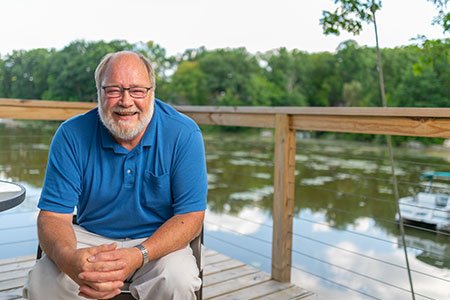Evan's Story
After decades of heart issues and procedures, Evan needed an alternative to bypass surgery. He found it from Henry Ford in a non-invasive procedure called CTO PCI. He is now back to his active lifestyle and feeling better than ever.
 In 1998, IT technician Evan Hostettler was working at a machine shop one day. Suddenly, a piece of plaque (a waxy substance made up of cholesterol and other materials) broke off in one of his coronary arteries, causing an immediate blockage and heart attack.
In 1998, IT technician Evan Hostettler was working at a machine shop one day. Suddenly, a piece of plaque (a waxy substance made up of cholesterol and other materials) broke off in one of his coronary arteries, causing an immediate blockage and heart attack.
Fortunately, luck was on his side.
“Two of the machinists were paramedics,” Evan says. “They saved my life and got me to the hospital.”
The medical team worked to place a stent in Evan’s coronary artery and remove the piece of plaque. While he initially felt better and was able to get back to his active walking lifestyle, he didn’t know that this first experience would be just one of many.
Several years later, he had to have a second stent placed. Then an ICD implant (a pacemaker with a defibrillator), which prompted additional procedures over the years to replace the batteries or the device itself. Evan’s life changed drastically, including facing new restrictions. Still, he was in good spirits and determined to pursue as active of a lifestyle as he could.
But two years ago, it all came to a crashing halt. Evan was very tired, to the point where he couldn’t even walk with his friends. His cardiologist checked the ICD and everything was fine, so they decided to do a diagnostic procedure, which showed that Evan had 100 percent blockage in one of his coronary arteries. They tried to put in another stent.
This time, it failed.
After decades of heart issues and procedures, Evan needed an alternative to bypass surgery. He found it from Henry Ford in a non-invasive procedure called CTO PCI. He is now back to his active lifestyle and feeling better than ever.
“When I woke up back in the recovery room, they said they couldn’t do the procedure,” Evan says. “I would either have to go try another procedure, have open heart surgery to get it repaired, go on real strict medicines … or leave it all alone and just live that way until I died.”
Evan didn’t want open heart surgery or any additional restrictions on his active lifestyle, so he and his wife did their own research online to find non-surgical alternatives to bypass surgery. They learned about an advanced procedure at Henry Ford known as chronic total occlusion percutaneous coronary intervention (CTO PCI).
When they met with Dr. Khaldoon Alaswad, director of the Henry Ford Hospital Catheterization Laboratory, he explained how it works. Henry Ford is one of few to offer this minimally invasive procedure, which uses catheters and tiny wires to drill through or around coronary artery blockages.
“We agreed right then and there that we were gonna do it,” Evan says.
Two weeks later, Evan had the CTO PCI procedure, and it was a success.
“I got home, and I immediately felt good,” Evan says. “I didn’t do anything for the first few days, but on the third day, I decided to test it out and I walked on the treadmill for 20 minutes. Now before, I wouldn’t have been able to do five minutes, so I knew the procedure had worked.”
As time progressed, Evan felt better and better, and was able to get back to his walking with no problems. He wasn’t running out of breath or getting any pain.
We use cookies to improve your website experience. By using this site, you agree to our Terms of Use. Read our Internet Privacy Statement to learn what information we collect and how we use it.